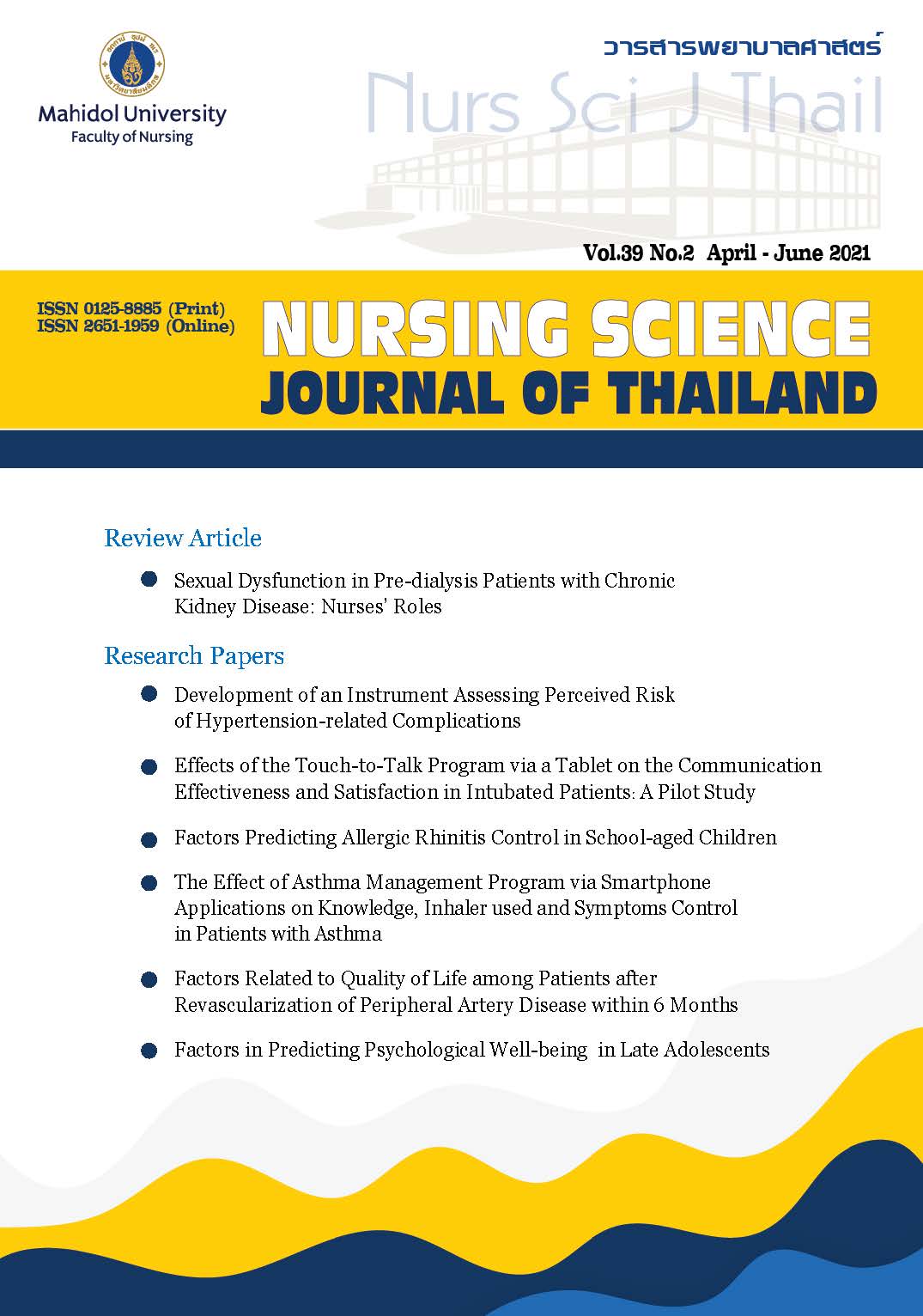Effects of the Touch-to-Talk Program via a Tablet on Communication Effectiveness and Satisfaction in Intubated Patients A Pilot Study
Main Article Content
Abstract
Purpose: To study the effects of the "Touch-to-Talk" program via a tablet on the communication effectiveness and satisfaction in intubated patients.
Design: A quasi-experimental study using one-group pretest–posttest design.
Methods: Participants comsisted of 10 intubated patients who were selected by simple random sampling from three medical semi-intensive care wards of a tertiary hospital. The participants were required to use the "Touch-to-Talk" program via a tablet to communicate with nurses for 24 hours. The research instruments consisted of 1) a demographic questionnaire, 2) a communication factors assessment form, 3) an effectiveness of communication scale, and 4) a satisfaction assessment form. Data were analyzed using descriptive statistics and the Wilcoxon Signed Rank Test.
Main findings: It was found that after receiving the program the participants had a mean score of communication effectiveness higher than before, comparing the mean scores of 9.2 (SD = 0.53) and 5.59 (SD = 1.74), respectively. The difference of mean scores of communication effectiveness was statistically significant (t = .01, p < .05). Moreover, the participants were highly satisfied with the program with a mean score of 4.53 (SD = 0.98).
Conclusion and recommendations: The results showed that the Touch-to-Talk program improved communication between intubated patients and healthcare providers. However, this is a pilot study; thus, a further experimental study using a larger sample size should be implemented.
Article Details
Copyright Notice: Nursing Science Journal of Thailand has exclusive rights to publish and distribute the manuscript and all contents therein. Without the journal’s permission, the dissemination of the manuscript in another journal or online, and the reproduction of the manuscript for non-educational purpose are prohibited.

Disclaimer: The opinion expressed and figures provided in this journal, NSJT, are the sole responsibility of the authors. The editorial board bears no responsibility in this regard.
References
Khalaila R, Zbidat W, Anwar K, Bayya A, Linton DM, Sviri S. Communication difficulties and psychoemotional distress in patients receiving mechanical ventilation. Amp J Crit Care. 2011;20(6):470-9. doi: 10.4037/ajcc2011989.
Holm A, Dreyer P. Use of communication tools for mechanically ventilated patients in the intensive care unit. Comput Inform Nurs. 2018;36(8):398–405. doi: 10.1097/CIN.0000000000000449.
Rustam JS, Kongsuwan W. Communication in patients with ventilation support: an integrative review. Songklanagarind Journal of Nursing. 2017;37 Suppl:25–31. (in Thai).
Choi J-Y, Campbell ML, Gélinas C, Happ MB, Tate J, Chlan L. Symptom assessment in non-vocal or cognitively impaired ICU patients: implications for practice and future research. Heart Lung. 2017;46(4):239-45. doi: 10.1016/j.hrtlng.2017.04.002.
Karlsson V, Forsberg A, Bergbom I. Communication when patients are conscious during respirator treatment-a hermeneutic observation study. Intensive Crit Care Nurs. 2012;28(4):197-207. doi: 10.1016/j.iccn.2011.12.007.
Hoorn ST, Elbers PW, Girbes AR, Tuinman PR. Communicating with conscious and mechanically ventilated critically ill patients: a systematic review. Crit Care. 2016;20(1):333. doi: 10.1186/s13054-016-1483-2.
Boonsom P. Information to communicate, communication method and the efficiency of communication as perceived by patients while in the intubation [master’s thesis]. Songkhla: Prince of Songkla University; 2007. 83 p. (in Thai).
Pakkeraga W, Wongpiriyayothar A, Wongpanarak N. The effects of communication with handheld computer on satisfaction in communication among endotracheal intubation patients. Journal of Nursing Association of Thailand, North-Eastern Division. 2013;31(2):72–9. (in Thai).
Rodriguez CS, Rowe M, Thomas L, Shuster J, Koeppel B, Cairns P. Enhancing the communication of suddenly speechless critical care patients. Am J Crit Care. 2016;25(3):e40-7. doi: 10.4037/ajcc2016217.
Kaur S, Agnihotri M, Dhandapani M, Lakshmanan G, Mukherjee KK. Effectiveness of communication chart on patient satisfaction among conscious intubated patients: a randomized controlled trial. Journal of Nursing Science & Practice. 2018;8(3):15-23. doi: 10.37591/jonsp.v8i3.449.
Chan-ui P, Thaniwattananon P, Petpichetchian W. Effects of communication card on received care based on needs and perceived communication frustration in endotracheal intubated patients. Journal of Nursing Science and Health. 2010;33(3):1-11. (in Thai).
Carruthers H, Astin F, Munro W. Which alternative communication methods are effective for voiceless patients in intensive care units? a systematic review. Intensive Crit Care Nurs. 2017;42:88-96. doi: 10.1016/j.iccn.2017.03.003.
Holm A, Dreyer P. Intensive care unit patients’ experience of being conscious during endotracheal intubation and mechanical ventilation. Nurs Crit Care. 2017;22(2):81-8. doi: 10.1111/nicc.12200.
Otuzoglu M, Karahan A. Determining the effectiveness of illustrated communication material for communication with intubated patients at an intensive care unit. Int J Nurs Pract. 2014;20(5):490-8. doi: 10.1111/ijn.12190.
Ruangritchankul S, Krairit O. Chronic pain assessment in the elderly. Ramathibodi Medical Journal. 2018;41(3):92-9. (in Thai). doi: 10.14456/rmj.2018.24.
Cohen J. Statistical power analysis for the behavioral science. 2nd ed. Hillsdale NJ: Lawrence Erlbaum Associates; 1988. 567 p.
Wongrattana C. Techniques for using statistics for research. 10th ed. Nonthaburi: Thainaeramitegit Inter Progressive Publisher; 2007. 381 p. (in Thai).
Lomas J, Pickard L, Bester S, Elbard H, Finlayson A, Zoghaib C. The communicative effectiveness index: developmental and psychometric evaluation of a functional communication measure for adult aphasia. J Speech Hear Disord. 1989;54(1):113-24. doi: 10.1044/jshd.5401.113.
Radtke JV, Tate JA, Happ MB. Nurses’ perceptions of communication training in the ICU. Intensive Crit Care Nurs. 2012;28(1):16-25. doi: 10.1016/j.iccn.2011.11.005.
Dithole KS, Thupayagale-Tshweneagae G, Akpor OA, Moleki MM. Communication skills intervention: promoting effective communication between nurses and mechanically ventilated patients. BMC Nurs. 2017;16:74. doi: 10.1186/s12912-017-0268-5.
Grossbach I, Stranberg S, Chlan L. Promoting effective communication for patients receiving mechanical ventilation. Crit Care Nurse. 2011;31(3):46-60. doi: 10.4037/ccn2010728.
Thienmongkol R. The study of fonts legibility for elders: a contextual of Thai alphabets on tablet screen. Veridian E-Journal, Silpakorn University. 2017;10(3):1066-82. (in Thai).
Sirindhorn National Medical Rehabilitation Institute, Department of Medical Services, Ministry of Public Health. Care for patients and the disabled through hearing or meaning [Internet]. Nonthaburi: Sahamitr Printing and Publishing; 2015 [cited 2019 Dec 10]. Available from: http://www.snmri.go.th/snmri/download/book_disability/voice_book.pdf. (in Thai).
Polnoog S. Evaluation of the musculoskeletal system [Internet]. Phitsanulok: Textbook Project, Faculty of Nursing, Naresuan University; 2009 [cited 2019 Dec 10]. Available from: https://www.slideshare.net/UtaiSukviwatsirikul/ss-35699174. (in Thai).
Hosseini S-R, Valizad-Hasanloei M-A, Feizi A. The effect of using communication boards on ease of communication and anxiety in mechanically ventilated conscious patients admitted to intensive care units. Iran J Nurs Midwifery Res. 2018;23(5):358-362. doi: 10.4103/ijnmr.IJNMR_68_17.


